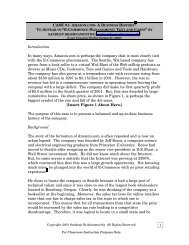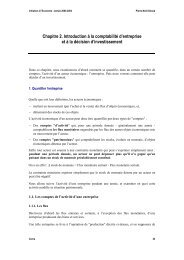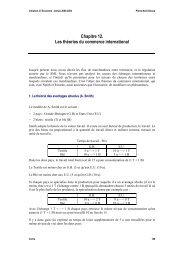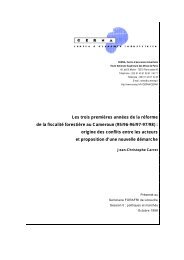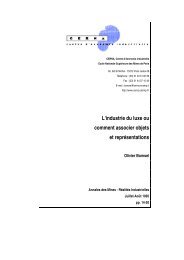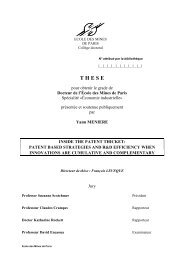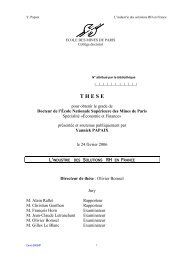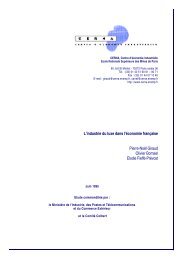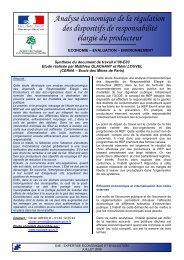The Conduct vs. Structural Remedies Controversy: an ... - Cerna
The Conduct vs. Structural Remedies Controversy: an ... - Cerna
The Conduct vs. Structural Remedies Controversy: an ... - Cerna
Create successful ePaper yourself
Turn your PDF publications into a flip-book with our unique Google optimized e-Paper software.
CERNA, Centre d’économie industrielle<br />
Ecole Nationale Supérieure des Mines de Paris<br />
60, bld St Michel - 75272 Paris cedex 06<br />
Tél. : (33) 01 40 51 91 73<br />
Fax : (33) 01 44 07 10 46<br />
E-mail : leveque@cerna.ensmp.fr<br />
http ://www.cerna.ensmp.fr/<br />
<strong>The</strong> <strong>Conduct</strong> <strong>vs</strong>. <strong>Structural</strong> <strong>Remedies</strong> <strong>Controversy</strong>:<br />
<strong>an</strong> Irrelev<strong>an</strong>t Dichotomy of Antitrust Policy Instruments<br />
Fr<strong>an</strong>çois Lévêque<br />
Working Paper, May 2000
<strong>The</strong> <strong>Conduct</strong> <strong>vs</strong>. <strong>Structural</strong> <strong>Remedies</strong> <strong>Controversy</strong>:<strong>an</strong> Irrelev<strong>an</strong>t Dichotomy of Antitrust Policy Instruments<br />
Fr<strong>an</strong>çois Lévêque<br />
<strong>The</strong> Microsoft trial has entered into its remedy stage. Some parties (SIIA, 1999 ; Salop, 1999 ;<br />
Lit<strong>an</strong> et alii, 2000) ask for structural remedies like vertical <strong>an</strong>d horizontal divesture whereas<br />
others claim restrictions on Microsoft behaviour by m<strong>an</strong>datory rules of conduct. For pro<br />
plaintiffs parties structural remedies are more stringent, easier to enforce <strong>an</strong>d more effective.<br />
For supporters of Bill Gates' comp<strong>an</strong>y such remedies are disproportionate <strong>an</strong>d conduct remedies<br />
would suffice to put <strong>an</strong> end to Microsoft <strong>an</strong>ti-competitive behaviour. This conduct <strong>vs</strong>. structural<br />
remedies controversy is based on <strong>an</strong> over-simplifying <strong>an</strong>d confusing classification of <strong>an</strong>titrust<br />
policy instruments. <strong>The</strong> reason is that it mixes two independ<strong>an</strong>t features of policy instruments:<br />
whether they are based on a comm<strong>an</strong>d-<strong>an</strong>d-control or <strong>an</strong> incentives approach; whether they<br />
concern a firm's environment, its outputs, its org<strong>an</strong>isation or its property rights.<br />
Table 1: Assumed properties of structural <strong>an</strong>d conduct remedies<br />
<strong>Remedies</strong> Enforceable Stringent Effective<br />
<strong>Structural</strong> + + +<br />
<strong>Conduct</strong> - - -<br />
Table 1 sums up the current controversy about the remedies to use against Microsoft. <strong>Conduct</strong><br />
<strong>an</strong>d structural remedies are considered as two separate families of instruments. <strong>The</strong> former<br />
prescribes or proscribes certain behaviour. <strong>The</strong> latter modifies a firm's org<strong>an</strong>isation. <strong>Structural</strong><br />
remedies are viewed as nipping <strong>an</strong>ti-competitive behaviour in the bud because they suppress a<br />
firm's incentives to unlawfully behave. In contrast, under conduct remedies a firm's economic<br />
interest to break <strong>an</strong>titrust law remains in place. As a consequence, structural remedies are<br />
largely self-executing whereas conduct remedies require perm<strong>an</strong>ent intervention of public<br />
authorities. This is why structural remedies are supposed to be less costly to enforce. Moreover,<br />
they are considered as more stringent because this characteristic which largely features<br />
divesture is generalised to other structural remedies. Similarly, they are said to be more<br />
effective because divesture is a me<strong>an</strong>s to restaure competition <strong>an</strong>d this is generalised to other<br />
structural remedies.<br />
Such a view is over-simplifying <strong>an</strong>d confusing. <strong>Structural</strong> remedies as Chinese walls to bar<br />
information exch<strong>an</strong>ge between different units <strong>an</strong>d m<strong>an</strong>datory accounting separation of<br />
integrated activities to facilitate third party access to <strong>an</strong> essential facility are not especially easy<br />
<strong>Cerna</strong> 2
<strong>The</strong> <strong>Conduct</strong> <strong>vs</strong>. <strong>Structural</strong> <strong>Remedies</strong> <strong>Controversy</strong>:<strong>an</strong> Irrelev<strong>an</strong>t Dichotomy of Antitrust Policy Instruments<br />
Fr<strong>an</strong>çois Lévêque<br />
to enforce : Information exch<strong>an</strong>ge is difficult to observe <strong>an</strong>d accounting separation requires<br />
perm<strong>an</strong>ent regulator scrutiny to check how joint costs are allocated. Even some forms of<br />
divesture may require signific<strong>an</strong>t ex post involvement of administration. Functional break-up is<br />
<strong>an</strong> example. Business lines evolves with ch<strong>an</strong>ges in technology <strong>an</strong>d dem<strong>an</strong>d. Public authorities'<br />
involvement is thus necessary to ensure compli<strong>an</strong>ce with the maintening of business lines breakup.<br />
On the contrary, some conduct remedies may require a low involvement of administration.<br />
For inst<strong>an</strong>ce, <strong>an</strong> injunction to publish a price list to remedy to discriminatory pricing is easy to<br />
monitor. Moreover, some remedies as those concerning intellectual property rights are difficult<br />
to r<strong>an</strong>ge into the conduct or structural categories. In the SIIA report (1999), compulsory<br />
licensing of Windows source code is mentioned as a conduct remedy whereas the establishment<br />
of Windows OS family as open source software is r<strong>an</strong>ged as a structural remedy ! According to<br />
Lit<strong>an</strong> et alii (2000), licensing remedies belong to the category of structural remedies. As far as<br />
effectiveness is concerned, the insights provided by the conduct/structure dichotomy are also<br />
confusing. Effectiveness must be assessed depending on the objective which is pursued. If<br />
remedies'goal is impeding past unlawfull conduct to repeat (e.g., compelling Microsoft to<br />
disbundle its operating system <strong>an</strong>d Internet browser <strong>an</strong>d impeding the comp<strong>an</strong>y to leverage on<br />
new segments of the market) conduct remedies may be effective me<strong>an</strong>s. If the aim is to kick<br />
start the market back to competitive condition, only some structural remedies as divesture may<br />
be effective. It is import<strong>an</strong>t to notice that even break-up is not the p<strong>an</strong>acea. <strong>The</strong> functional<br />
divesture as proposed by <strong>an</strong>titrust division is likely to reduce application barriers but does not<br />
instaure workable competition on the OS market for the monopoly is not dism<strong>an</strong>tled.<br />
<strong>The</strong> dichotomy is confusing because it mixes two distinct features of policy instruments: the<br />
policy approach which is used <strong>an</strong>d the firm component which is targeted. <strong>The</strong> independ<strong>an</strong>cy of<br />
these two features is put in evidence in table 2 with exemples of policy instruments used in<br />
different areas (environmental policy, tort law, public utilities regulation, etc.) <strong>an</strong>d exemples of<br />
different remedies which may be used in the case of USA <strong>vs</strong>. Microsoft Coropration.<br />
Table 2: Two independ<strong>an</strong>t features of policy instruments<br />
Policy approach<br />
Comm<strong>an</strong>d-<strong>an</strong>d-Control<br />
Providing incentives<br />
Target<br />
A firm’s environment (1) Liability rules<br />
Antitrust penalties<br />
A firm’s outputs (e.g., price, qu<strong>an</strong>tity, Cost-plus tariffs, polluting emissions st<strong>an</strong>dards Fixed-price tariffs, environmental charges<br />
quality)<br />
Operating System/Internet Explorer Price Cap on Windows<br />
A firm’s frontiers (e.g., structural<br />
<strong>an</strong>titrust remedies)<br />
Property Rights<br />
Disbundling<br />
Accounting separation<br />
Chinese Walls between Windows <strong>an</strong>d<br />
Application businesses<br />
L<strong>an</strong>d takings<br />
Application Programming Interfaces<br />
Disclosure<br />
Divestiture<br />
Microsoft Break-up<br />
Patents<br />
Vari<strong>an</strong>’s Proposal<br />
(1) In market economies, public intervention is not allowed to constrain all the parameters of business environment, that is why<br />
there is no comm<strong>an</strong>d-<strong>an</strong>d-control instruments targeted on a firm's environment.<br />
<strong>Cerna</strong> 3
<strong>The</strong> <strong>Conduct</strong> <strong>vs</strong>. <strong>Structural</strong> <strong>Remedies</strong> <strong>Controversy</strong>:<strong>an</strong> Irrelev<strong>an</strong>t Dichotomy of Antitrust Policy Instruments<br />
Fr<strong>an</strong>çois Lévêque<br />
Whatever public policy deals with <strong>an</strong>titrust, public utilities, pollution abatement or scientific<br />
research a key distinction of instruments is whether they are comm<strong>an</strong>d-<strong>an</strong>d-control instruments<br />
(also called regulatory instruments) or economic instruments (also called incentives<br />
instruments). <strong>The</strong> latter create economic incentives for firms to adopt socially desirable<br />
behaviour. Whether firms would ch<strong>an</strong>ge their behaviour or not depends on a cost-benefit<br />
<strong>an</strong>alysis. For inst<strong>an</strong>ce, a Pigovi<strong>an</strong> tax on CO2 will result in pollution abatement whenever the<br />
marginal abatement cost is higher th<strong>an</strong> the amount of the charge per unit of emissions. Liability<br />
rules are <strong>an</strong>other classical example of economic instruments. <strong>The</strong>y provide incentives to avoid<br />
accidents. <strong>The</strong>y leave firms decide to invest in accident prevention or pay damages when they<br />
occur. Penalties, if rightly tailored, are also incentives instruments. <strong>The</strong> firm would not break<br />
out a rule if its benefit to do it is less th<strong>an</strong> the expected costs of the s<strong>an</strong>ction. Penalties are<br />
commonly used instruments in the field of <strong>an</strong>titrust policy.<br />
Regulatory instruments corresponds with <strong>an</strong>other approach of government intervention. Instead<br />
of creating incentives, government says to a firm's how to behave; it comm<strong>an</strong>ds <strong>an</strong>d controls<br />
their actions. In contrast to economic instruments, a firm's me<strong>an</strong>s to behave against social<br />
welfare are constrained but not its incentives.<br />
<strong>The</strong> second feature of policy instruments relates to their target. Instruments act upon different<br />
components of business. <strong>The</strong>y may concern a firm's environment, its outputs, its org<strong>an</strong>isation,<br />
its property rights <strong>an</strong>d so forth.<br />
Historically, economic theory has mainly delt with regulatory instruments targeting a firm's<br />
output, that is price, qu<strong>an</strong>tity or quality of products. Classical examples are emission st<strong>an</strong>dards<br />
in environmental policy, cost-plus pricing in public utilities regulation, quota in agriculture<br />
policy ; quality st<strong>an</strong>dards in consumers policy, etc. It would be wrong to conclude that<br />
instruments policy which are targeted on outputs belong to the type of Comm<strong>an</strong>d-<strong>an</strong>d-Control.<br />
One of the main progress made by so-called new economics of regulation (Laffont <strong>an</strong>d Tirole,<br />
1996) is merely to have elaborated incentives intruments to regulate public utilities (e.g., price<br />
cap).<br />
Most of <strong>an</strong>titrust instruments act upon a firm's structure. M<strong>an</strong>datory divesture before the<br />
authorization of mergers <strong>an</strong>d acquisitions are classical examples as well as (albeit less<br />
frequent).divesture as <strong>an</strong> <strong>an</strong>titrust remedy. In public utilities regulatory reform, structural<br />
instruments have also been used (e.g., divesture of Bristish Rail, accounting separation of the<br />
French electricity system operator within EDF.As<br />
well as outputs <strong>an</strong>d structure targeted<br />
instruments, remedies targeted on property rights may belong either to comm<strong>an</strong>d-<strong>an</strong>d-control or<br />
incentives instruments. Intellectual property rules provide incentives for innovation <strong>an</strong>d firms<br />
<strong>Cerna</strong> 4
<strong>The</strong> <strong>Conduct</strong> <strong>vs</strong>. <strong>Structural</strong> <strong>Remedies</strong> <strong>Controversy</strong>:<strong>an</strong> Irrelev<strong>an</strong>t Dichotomy of Antitrust Policy Instruments<br />
Fr<strong>an</strong>çois Lévêque<br />
would decide to patent their inventions or keep them secret depending on the duration of<br />
exclusivity they are gr<strong>an</strong>ted. An example of intellectual property incentives to remedy to<br />
Microsoft <strong>an</strong>ti-competitive behaviour is the proposal adv<strong>an</strong>ced by Hal R. Vari<strong>an</strong>. It consists in<br />
requiring Microsoft to license binary versions of its operating system more th<strong>an</strong> X months old<br />
(say, 36 months) at a flat price of $ Y per license (say $10). X <strong>an</strong>d Y are variables set <strong>an</strong>d fine<br />
tuned by public authorities. In contrast, the disclosure of application programing interfaces to<br />
facilitate application sofware comp<strong>an</strong>ies to develop complementary product to Windows does<br />
not ch<strong>an</strong>ge Microsoft incentives. Its interest would remain not to comply with this rule in order<br />
to give adv<strong>an</strong>tage to Microsoft applications product.<br />
As a conclusion, the dichotomy structure <strong>vs</strong> conduct instruments is inappropriate to discuss<br />
remedies that must be undertaken to end with Microsoft <strong>an</strong>ti-competitive behavior.<br />
References<br />
Laffont J.-J. <strong>an</strong>d Tirole J. (1993), A <strong>The</strong>ory of Incentives in Procurement <strong>an</strong>d Regulation, MIT<br />
Press, Cambridge.<br />
Lit<strong>an</strong> R. E., Noll R.G., Nordhaus W.D., Sherer F.M. (2000), <strong>Remedies</strong> Brief of Amici Curiae.<br />
Salop C. S. <strong>an</strong>d R.C. Romaine (1999), Preserving Monopoly : Economic Analysis, Legal<br />
St<strong>an</strong>dards, <strong>an</strong>d Microsoft, George Masson Law Review, vol. 7, n° 3, pp 617-671.<br />
SIIA (1999), Addressing the Microsoft Challenge – Restauring Competition To the Software<br />
Industry.<br />
Vari<strong>an</strong> H. R. (1999), A framework for Negotiaition on a Microsoft Remedy,<br />
http://wwww.sims.berkeley.edu/ hal/Papers/clobr.html<br />
<strong>Cerna</strong> 5



